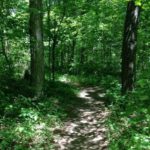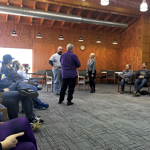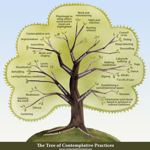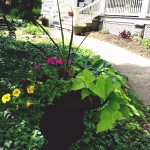When Greg Hitzhusen was a student at Yale Divinity School, he and a few others started an Outing Club, which took students out onto the campus for weekly meditations, and also took a spring break hiking trip every year. One day, while they were hiking in North Carolina, they came out onto Shining Rock at sunset and saw forested land spreading before them for miles. They had what Greg describes as a collective spiritual experience. This experience was the fruit of the group’s deep investment in their exploration of nature spirituality, and their acceptance of the hard work of being in the wild.
It was a high point of Greg’s many years spent exploring nature spirituality, during which he found many profound teachers. A few years before, he’s taken part in the Yitziah Jewish Outdoor Leadership Training Course, and become fascinated by the spiritual communities that can spring up in the midst of wilderness programs. He concentrated his academic research on similar outdoor environmental ministries, delving into how they thought about their work, both practically and theologically. He found that they all emphasized spiritual growth and renewal, often tying participants’ experiences to the wilderness stories of the Jewish and Christian traditions. His research made him conversant with a number of writers on creation spirituality, such as Stephen Kellert, Ursula Goodenough, and Bron Taylor.
We’d invited him to the Ministerium because we wanted to explore the idea of pilgrim communities, groups of people who come together for a set religious purpose, for a limited amount of time, and then disperse when that purpose is accomplished. Could these outdoor ministries serve as an example of such pilgrim communities, we wondered, and if so, what could we learn from them? Part of our concern was over their accessibility. Is there a way participate in pilgrim communities that are based around nature spirituality, even if one isn’t physically able to go on long hiking trips. or prevented from doing so by family or work responsibilities? Yes, Greg told us, all you need is a group that is intentional about going outside. He told us about the square foot exercise, in which one spends an hour simply meditating on a square foot of ground. Even such a simple thing can lead one to state of wonder and awe, since every small patch of ground is so amazingly various.
But the best practices for forming a pilgrim community in nature do require immersion in the natural world, which is best accomplished through multi-day excursions. Greg said that groups of twelve to fifteen people are best, since they allow for intimacy and variety without becoming unmanageable. A lot of very intentional planning needs to go into a successful trip. It’s a good idea to ground the trip in worship, maybe starting and ending with liturgies within a home trip. This, indeed, is one place where he nuanced our idea of pilgrim communities, since many of the groups that head out on these trips do so from a synagogue or church, a base community which supports them and which they benefit through their pilgrimage.
Once the group has started out on the trail, it’s important to engage them in what Greg calls a “portal” exercise. These are exercises that are meant to mark the liminality of beginnings, where pre-existing concerns and worries are named and then left behind. Through these exercises, a group begins to know itself as a group. Part of a group’s formation is its coming to understand the importance of mutual leadership. Sometimes groups of people assume that, regardless of any rhetoric around learning to trust one’s own leadership, there will, at the end of the day, always be someone there to bail them out. Experienced trail guides know that the only way to counter this assumption is to let group leaders fail, even if it means that they take people for miles in the wrong direction. Through such an experience, they come to understand that their leadership really belongs to them, and isn’t merely a hollow rhetorical device.
During these journeys, participants learn to value something other than peak-chasing. Sometimes the most profound moment doesn’t come on a mountain top, but while wading through weeds and bracken. And on all of these journeys, participants learn what their Jewish and Christian spiritual forerunners always knew – that the wilderness has the capacity of clearing away the distractions of our lives, and helping us notice the presence of God all around us.
Towards the end of his talk, Greg paraphrased Thomas Aquinas, who said that no one thing can adequately reflect the goodness of God, which is why God made all things. Often our faith communities become inward focused, and fall into thinking that they, somehow, know all there is to say about God. But creation is saying something more. Can we, as pilgrim communities, open the book of nature and learn from it?






